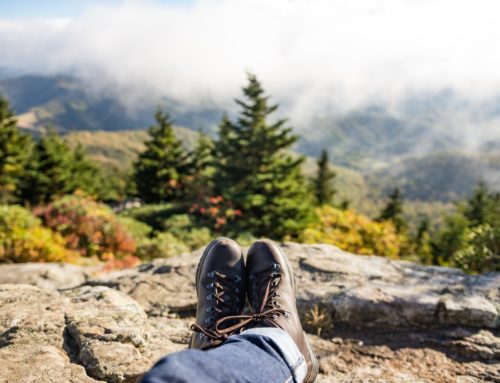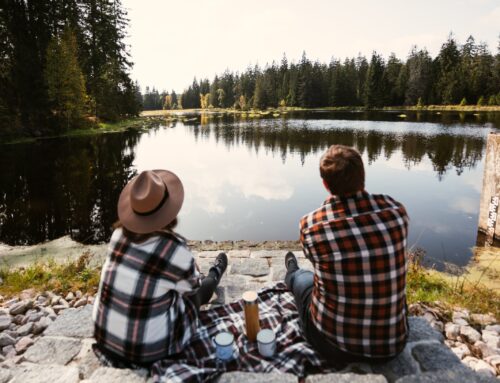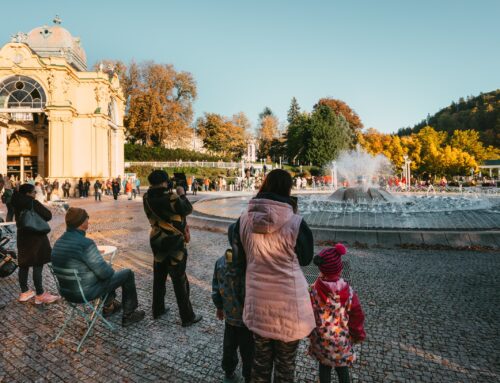Don’t want to take a long flight to an island in the Caribbean? Then explore Ostrov (the island) that’s right at your fingertips. A picturesque town located at the foot of the Ore Mountains, not far from Karlovy Vary. Beautiful nature in the vicinity of Borecké rybníky, modern disc golf and rich history. Lots of reasons why this town is worth exploring. Already planning a trip?
The town of Ostrov is a bit more complicated with its name. It got its almost poetic name thanks to the fact that it can be found between the rivers Bystřice and Veseřice in the vicinity of the ponds. However, Ostrov is increasingly finding itself in a schizophrenic situation. Although the official name is “just” Ostrov, if you arrive by train, you will be pompously greeted by the sign Ostrov nad Ohří. A bit of a mess, isn’t it? That is why there are growing calls for the town to get its former nickname back. Such a change is only theoretically considered for now, because changing the name would be very administratively demanding. However, if you go from Karlovy Vary to Jáchymov, you cannot miss the correct Ostrov.
We’ve already explained the name. But why go to Ostrov The town at the foot of the Ore Mountains boasts not only a rich history, but also a beautiful surrounding landscape. The historic core of Ostrov is a town conservation area and the oldest preserved building is the cemetery church of St. James the Greater from the beginning of the 13th century. Another important monument, which is definitely worth a visit, is the impressive castle with its glass Dvorana built by the Šlik family together with the castle garden. The Palace of the Princes with the White Gate and the Summer Palace, which houses an art gallery, are also inviting sights. Thanks to its location, Ostrov is a perfect starting point for trips to the surrounding area.

„Northern South Bohemia”
We recommend starting your journey to the natural beauty of the town on its northern edge, where the famous pond system known as the Borecké Ponds is located. The landscape around the town has been enriched by water levels since the 16th century. Pond farming developed greatly in the 17th century, when there were as many as ninety ponds. Two centuries later, most of them were converted into meadows and pastures. However, we can still say with exaggeration that you can find a smaller South Bohemia here, but without the annoying bustle. And that’s why you can enjoy the charm of the landscape to the full.
The system of Borecké Ponds currently consists of nine water bodies, namely Velký Borek, Horní and Dolní Hlinice, Mulda, Lučný, Hluboký, Koňský, Ostrovský Velký and one unnamed pond. The area is just under 43 hectares, of which 8 hectares are occupied by the largest pond – the aforementioned Velký Borek.
The Borecké Ponds have their own secrets, tranquillity and charm. You can go here for sport, for a walk or simply to recharge your batteries. There are paths between the ponds, which are used by hikers and cyclists. They are connected to local hiking and cycling trails. You can also see many protected plants and animals. For example, the rare amphibian great crested newt can be found here. And it is well known that it is found only in pristine and unspoilt nature.
The entire system of Borecké Ponds is surrounded by a 2.6 km long nature trail. From the town centre, it’s not far to reach it. You can find it by the local football field, where you can park conveniently. From the car park, it is only a short walk to the first of eight stops along the trail.
Round and round
If you prefer cycling to walking, we have some good tips for you too. You’ll love the easy circuit suitable for a touring bike along a mostly asphalt cycle path to the nearby village of Květnová. The difficulty is very easy, so you can also go here with children. The route is only 15 kilometres long and the elevation gain is less than 150 metres. More information about the route can be found here. The individual sections of the route are as follows:
Ostrov, Old Town – along the cycle path to Horní Žďár – Vykmanov – along the panel road to Květnová – along the cycle path to Dolní Žďár – Borecké rybníky – the cycle path Ostrovské Rondo – Ostrov, train station.
“Before by train, today by bike”. This is the motto of another cycle path. The towns of Jáchymov and Ostrov, which are linked primarily by a similar history, are also connected by a cycle path that was built on the route of the former railway line, including a stone tunnel. It was closed down in the 1950s after the end of uranium ore mining. Although the entire cycle path is only less than 3 kilometres long, don’t be fooled. This is by no means an easy recreational ride. The original railway is said to have had the biggest climb in the Czech Republic.

Discgolf on the meadow
But now we’re going in a completely different direction. Instead of holes, a steel basket, instead of a golf ball, a flying saucer. What’s going on? If you don’t know, get acquainted. Discgolf originated in the 1970s in the United States and has been gaining more and more fans around the world ever since. A public disc golf course can be found between the football field and Borecké Ponds, where you can play for free.
The rules of disc golf are very simple. The aim of the game is to hit the disc in as few attempts as possible into a special basket, which serves the same function as a hole in a classic golf game. The game starts at the “tee” of each hole and ends at the basket. There are six routes with distances ranging from 70 to 103 metres. You can rent the equipment, or rather discs, for a refundable deposit of 200 CZK in the nearby U Čepelíka pub. The game is not time-consuming. You play only as long as you enjoy it. And if you don’t have anyone with you? Never mind! You can play alone. It’s a challenge to face the course and get through it alone in the shortest possible time.

Red Tower of Death
The history of the city has its shadow side. Shortly after World War II, the Czechoslovak government pledged to supply all uranium ore mined on our territory to the then Soviet Union. The famous Škoda Ostrov produced trolleybuses for the domestic and world market. However, part of the site was used as a labour camp for political prisoners in the 1950s, which was established in February 1951. The Red Death Tower in Vykmanov had two tasks: sorting uranium ore and liquidating political prisoners. The seven-storey red brick building thus became part of the cruel camp (codenamed “L” for liquidation). The place soon got a terrifying nickname – the Red Tower of Death. Today, a local exhibition commemorates the horrors of the totalitarian prison.
The ore was brought here from all the shafts all over the country and crushed in a large mill. The crushing plant was located in a tall red brick building. All those who worked there (practically without protective equipment) came into direct contact with radioactive material and inhaled radioactive dust, which was carried by the wind to the adjacent camp. Whereas in the uranium mine a prisoner was only exposed to direct radiation when he or she hit an ore vein, here the prisoner was exposed to radiation all the time. About 300 prisoners were forced to work in the camp.
The Red Tower of Death is one of five sites in the Czech Republic that were inscribed on the UNESCO World Heritage List on 6 July 2019, along with 17 other sites in Saxony under the collective name of the Erzgebirge/Krušnohoří Mining Region.
While we didn’t end on a positive note, this too is part of Ostrov rich history that should not be overlooked. We believe that here you will discover not only fun, untouched nature, but also lessons. Explore the town of Ostrov that’s right at your fingertips!





